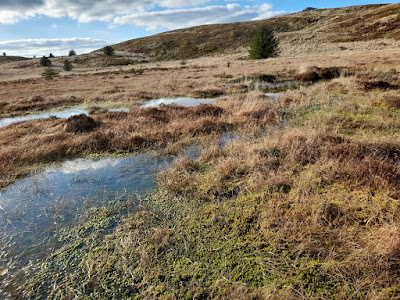A
New Moss for Wales

A lockdown moss found by a gravel track through woodland near the author’s
home in Cardiganshire proved to be more interesting than first thought. It looked like a rather long-leaved form of
Barbula in the field but, on closer examination, the basal cells were clearly
wrong for that. It was provisionally
thought it might be a Didymodon, possibly related to D. umbrosus which has
similarly enlarged median basal cells but it sat on the desk for a while, in some
danger of being put in the bin. Then
eventually I sent it to Tom Blockeel who, by chance, had collected something rather similar in Ireland nearly 20 years ago which had had some of the characters of
Bryoerythrophyllum campylocarpum but had never been satisfactorily confirmed as
that. But this time we were able to get
Jan Kucera involved and he has now sequenced a Welsh specimen and confirms it
as B. campylocarpum. He comments that it’s
a little closer to samples from Cameroon than from its only European sites in
northern Portugal. It is primarily a
tropical species.


Since the first collection, it has now been found at 4
points along the same forestry track plus one other site about 1 km away. The later site is however a very different
habitat.
In appearance, short leaved forms (the pictures here are of plants with more elongate leaves) look a little like B.
convoluta in general appearance, no doubt influenced by the unprepossessing habitat. The Welsh plants are a similar colour too,
being quite light green but in Ireland
it is more brick-red in colour. At the
Goginan site however, no Barbula of any species has actually been found, the
shale used to make the track resulting in quite acid conditions. The commonest associated bryophyte on the forest track is
Campylopus subulatus but there are also species of Polytrichum s.l., Pohlia
annotina, Scapania irrigua and other frequent species of acid, well-drained
gravelly soils. Long-leaved forms look
more like a very small Trichostomum tenuirostre to use an older name, sometimes
even with comal tufts at the tops of the shoots. It is however only 5 – 8 mm high.

The leaf apex is interesting too. The upper cells are strongly papillose,
making the 12 micron quadrate cells hard to pick out sometimes. But there is a projecting smooth mucro formed
from 1 – 4 cells which is a real contrast.
The mucro sometimes has a spine on the side and this can result in it
appearing as a nearly symmetric fork.
Leaf margins are unbordered but with the margin recurved in the lower part of the leaf.
Unsurprisingly, there are similarities to B. recurvirostrum. It too has differentiated basal cells although there are many more rows of rather narrower hyaline cells across the base. But it does also have a few rows of narrower chlorophyllose cells towards the basal margin and even a single row of hyaline cells up the basal margin. Its preferred base-rich habitat would make it an unlikely candidate for confusion though. The simplest difference is of course the strongly recurved margins extending nearly to the leaf apex whereas B. campylocarpum has marginsonly recurved in the lower part of the leaf, sometimes hardly recurved at all. The upper part of the leaf is much narrower too.
The other site mentioned is on a low vertical rock face by
the edge of a ditch. The plants are
small here and would be likely to be overlooked as Dichodontium pellucidum
perhaps or even just a tiny Trichostomum tenuirostre.
The plants found to date have all been sterile (but see update below), supporting
the notion that it is likely to have been introduced. It seems possible that the Irish plants might
be distinct so we could be looking at separate introductions (but see below too). In any case it’s hard to see why it should
only be in Goginan and there are very many miles of similar track in Cardiganshire. If you factor in ditch banks then there is
clearly scope for it to be quite widespread in occurrence. In Portugal the few sites for it are acid to
circum-neutral but also on tracks. At
the Goginan site the track is much used by cyclists and it can be safely
assumed the plants are being spread vegetatively (by rhizoidal tubers) so that seems a likely means
of transmission.
It will all be written up of course but it would be good to
have more sites. It’s probably best to
start by sampling any Barbula that looks a bit long-leaved and then to check
the basal cells. This could well prove to be another moss that has slipped in 'under the radar'.
Update early April 2021. There is a lot of this moss on the waterfall walk at Devil's Bridge. It's about 2/3 of the way up the path that goes up the side of the falls and is on fine silt covering flattish rocks that the path crosses. It's a rather shorter-leaved form and the basal margins are hardly recurved so it was overlooked as Trichostomum brachydontium on previous visits. It's hard to say how long it's been there and T. brachydontium has been recorded from the site for years although that does genuinely occur in a few places. The new moss is on the path above Jacob's Ladder too. Rhizoidal gemmae were found and they are dark wine-red in colour with very large cells (up to 90 microns) and have so far defied attempts at photography. Tom Blockeel is investigating them further. A couple of the plants collected had immature archegonia forming. Jan Kucera has now shown the Irish population to be genetically similar to the Welsh.
Tom










